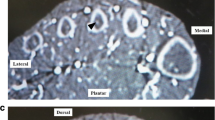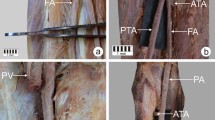Abstract
The location of nutrient foramina has been extensively studied in long bones; however, accurate information on the origin and extra-osseous course of the nutrient artery remains clearly defined in some long bones, although it is crucial to protect the nutrient arteries during operative procedures. In this study, we elucidated the origin and extra-osseous course of tibial and fibular nutrient arteries based on the 54 cadaveric legs. The tibial nutrient artery typically arose from the posterior tibial artery. Some of the tibial nutrient arteries arose from the anterior tibial, popliteal, and fibular arteries. The tibial nutrient artery arose from these parent arteries as a long descending branch. It penetrated the most proximal portion of the tibialis posterior or flexor digitorum longus to enter the tibial nutrient foramen. The fibular nutrient artery arose from the fibular artery as a short descending branch in all the cases. The fibular nutrient artery penetrated the flexor hallucis longus to enter the fibular nutrient foramen. Our present and previous findings provide new insight into the anatomical characteristics for the nutrient arteries in the long bones of upper and lower extremities. Namely, the nutrient arteries of the long bones go away from the elbow or knee to enter the nutrient foramina.







Similar content being viewed by others
References
Adachi B (1928) Das Arteriensystem der Japaner, vol I. Kaiserlich-Japanischen Universität zu Kyoto, Kyoto
Bleeker WA, Nijsten MW, ten Duis HJ (1991) Treatment of humeral shaft fractures related to associated injuries. A retrospective study of 237 patients. Acta Orthop Scand 62:148–153
Bock CE (1838) Handbuch der Anatomie des Menschen mit Berücksichtigung der Physiologie und chirurgischen Anatomie Friedrich Volckmar Leipzig
Braus H, Elze C (1960) Anatomie des menschen, ein lehrbuch für studierende und Ärzte. Springer, Berlin
Brookes M, Revell WJ (1998) Blood supply of bone: scientific aspects. Springer, London
Carroll SE (1963) A study of the nutrient foramina of the humeral diaphysis. J Bone Joint Surg Br 45B:176–181
Davis DV, Davis F (1963) Grayʼs Anatomy, descriptive and applied. Longmans Green & Co Ltd, London
Doyle JR, Botte MJ (2003) Surgical anatomy of the hand and upper extremity. Lippincott Williams and Wilkins, Philadelphia
Florio I, Wisser J, Huch R, Huch A (1999) Prenatal ultrasound diagnosis of a femur-fibula-ulna complex during the first half of pregnancy. Fetal Diagn Ther 14:310–312
Fordham LA, Applegate KE, Wilkes DC, Chung CJ (1999) Fibular hemimelia: more than just an absent bone. Semin Musculoskelet Radiol 3:227–238
Forriol Campos F, Gomez Pellico L, Gianonatti Alias M, Fernandez-Valencia R (1987) A study of the nutrient foramina in human long bones. Surg Radiol Anat 9:251–255
Gegenbaur C (1892) Lehrbuch der Anatomie des Menschen. Verlag von Wilhelm Engelmann, Leipzig, Germany
Gray H, Lewis WH (1918) Anatomy of the human body. Lea and Febiger, Philadelphia
Henle J (1968) Handbuch systematischen Anatomie des Menschen. Drück und Verlag von Friedrich Vieweg und Sohn, Braunschweig, Germany
Hoffmann CEE (1878) Lehrbuch der Anatomie des Menschen. Verlag von Eduard Besold, Erlangen, Germany
Huda S, Sangster G, Pramanik A, Sankararaman S, Tice H, Ibrahim H (2014) Hemimelia and absence of the peroneal artery. J Perinatol 34:156–158
Ichimura K, Kinose S, Kawasaki Y, Okamura T, Kato K, Sakai T (2017) Anatomic characterization of the humeral nutrient artery: aspplication to fracture and surgery of the humerus. Clin Anat 30:978–987
Ichimura K, Kinose S, Kawasaki Y, Kato K, Sakai T (2018) Reevaluation of the superior radial collateral artery in the human upper arm. Anat Sci Int 93:69–74
Kawasaki Y, Kinose S, Kato K, Sakai T, Ichimura K (2020) Anatomic characterization of the femoral nutrient artery: application to fracture and surgery of the femur. Clin Anat 33:479–487
Kim D, Orron DE, Skillman JJ (1989) Surgical significance of popliteal arterial variants. A unified angiographic classification. Ann Surg 210:776–781
Kinose S, Kanaya Y, Kawasaki Y et al (2018) Anatomic characterization of the radial and ulnar nutrient arteries in humans. Ann Anat 216:23–28
Lippert H, Pabst R (1985) Arterial variations in man, classification and frequency. J. F. Bergmann, Munchen
Macnab I (1957) Blood supply of the tibia. J Bone Joint Surg Br 39:799
Marenzana M, Arnett TR (2013) The key role of the blood supply to bone. Bone Res 1:203–215
Mysorekar VR (1967) Diaphysial nutrient foramina in human long bones. J Anat 101:813–822
Nagel A (1993) The clinical significance of the nutrient artery. Orthop Rev 22:557–561
Nicoll EA (1964) Fractures of the tibial shaft. A survey of 705 cases. J Bone Joint Surg Br 46:373–387
Olewnik L, Labetowicz P, Podgorski M, Polguj M, Ruzik K, Topol M (2019) Variations in terminal branches of the popliteal artery: cadaveric study. Surg Radiol Anat 41:1473–1482
Payton CG (1934) The position of the nutrient foramen and direction of the nutrient canal in the long bones of the madder-fed pig. J Anat 68:500–510
Piersol GJ, Huber GC (1930) Piersol’s human anatomy, including structure and development and practical considerations. J. B. Lippincott, Philadelphia
Romanes GJ (1981) Cunningham’s textbook of anatomy. Oxford University Press, Oxford
Schaeffer JP (1953) Morris’ human anatomy, a complete systematic treties. McGraw-Hill, New York
Skawina A, Wyczolkowski M (1987) Nutrient foramina of humerus, radius and ulna in human fetuses. Folia Morphol (Warsz) 46:17–24
Spiguel AR, Steffner RJ (2012) Humeral shaft fractures. Curr Rev Musculoskelet Med 5:177–183
Trueta J, Caladias AX (1964) A study of the blood supply of the long bones. Surg Gynecol Obstet 118:485–498
Walker M, Palumbo B, Badman B, Brooks J, Van Gelderen J, Mighell M (2011) Humeral shaft fractures: a review. J Shoulder Elbow Surg 20:833–844
Acknowledgements
The authors would like to thank Mr. Naoaki Kimura, Mr. Sora Kawamura, and Mr. Hironori Matsuda for their technical assistance. The authors also gratefully acknowledge the individuals who donated their bodies to Juntendo University. This article was made possible by the selfless gift from cadaver donors. This study was supported by an institutional fund from Juntendo University.
Author information
Authors and Affiliations
Corresponding author
Ethics declarations
Conflict of interest
The authors declare that they have no conflict of interest.
Additional information
Publisher's Note
Springer Nature remains neutral with regard to jurisdictional claims in published maps and institutional affiliations.
Rights and permissions
About this article
Cite this article
Anetai, H., Kinose, S., Sakamoto, R. et al. Anatomic characterization of the tibial and fibular nutrient arteries in humans. Anat Sci Int 96, 378–385 (2021). https://doi.org/10.1007/s12565-020-00600-9
Received:
Accepted:
Published:
Issue Date:
DOI: https://doi.org/10.1007/s12565-020-00600-9




